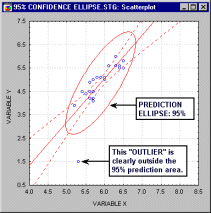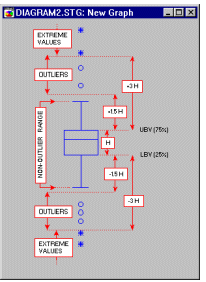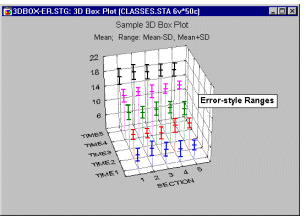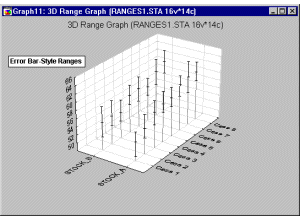

The ellipse is determined based on the assumption that the two variables follow the bivariate normal distribution. The orientation of this ellipse is determined by the sign of the linear correlation between two variables (the longer axis of the ellipse is superimposed on the regression line). The probability that the values will fall within the area marked by the ellipse is determined by the value of the coefficient that defines the ellipse (e.g., 95%). For additional information see, for example, Tracy, Young, and Mason (1992), or Montgomery 1996); see also the description of the prediction interval ellipse.
Range Ellipse: This type of ellipse is a fixed size ellipse determined such that the length of its horizontal and vertical projection onto the X- and Y-axis (respectively) is equal to the mean (Range * I) where the mean and range refer to the X or Y variable, and I is the current value of the coefficient field.
Endogenous Variable. An endogenous variable is a variable that appears as a dependent variable in at least one equation in a structural model. In a path diagram, endogenous variables can be recognized by the fact that they have at least one arrow pointing to them.
Enterprise-Wide Software Systems. Software applications designed to work in enterprise computer envirnoments (e.g., such as large corporate computer systems). Such applications typically feature extensive groupware functionality, and they are usually well integrated with large repositories of data stored in corporate data warehouses. See also Data Warehousing. For more information on enterprise-wide systems available from StatSoft, see STATISTICA Enterprise-Wide Systems.
Epoch in Neural Networks. During iterative training of a neural network, an Epoch is a single pass through the entire training set, followed by testing of the verification set.
For more information, see the Neural Networks chapter.
Error Bars (2D Box Plots). In this style of 2D Box plots, the ranges or error bars are calculated from the data. The central tendency (e.g., median or mean), and range or variation statistics (e.g., min-max values, quartiles, standard errors, or standard deviations) are computed for each variable and the selected values are presented as error bars.

The diagram above illustrates the ranges of outliers and extremes in the "classic" box and whisker plot (for more information about box plots, see Tukey, 1977).
Error Bars (2D Range Plots). In this style of 2D Range Plot, the ranges or error bars are defined by the raw values in the selected variables. The midpoints are represented by point markers. One range or error bar is plotted for each case. In the simplest instance, three variables need to be selected, one representing the mid-points, one representing the upper limits and one representing the lower limits.
Error Bars (3D Box Plots). In this style of 3D Sequential Box Plot, the ranges of values of selected variables are plotted separately for groups of cases defined by values of a categorical (grouping) variable. The central tendency (e.g., median or mean), and range or variation statistics (e.g., min-max values, quartiles, standard errors, or standard deviations) are computed for each variable and for each group of cases and the selected values are presented as error bars.

3D Range plots differ from 3D Box plots in that for Range plots, the ranges are the values of the selected variables (e.g., one variable contains the minimum range values and another variable contains the maximum range values) while for Box plots the ranges are calculated from variable values (e.g., standard deviations, standard errors, or min-max value).
Error Bars (3D Range Plots). In this style of 3D Sequential Range Plot, the error bars are not calculated from data but defined by the raw values in the selected variables. The midpoints are represented by point markers. One error bar is plotted for each case. The range variables can be interpreted either as absolute values or values representing deviations from the midpoint depending on the current setting of the Mode option in the graph definition dialog. Single or multiple variables can be represented in the graph.

3D Range plots differ from 3D Box plots in that for Range plots, the ranges are the values of the selected variables (e.g., one variable contains the minimum range values and another variable contains the maximum range values) while for Box plots, the ranges are calculated from variable values (e.g., standard deviations, standard errors, or min-max values).
Error Function in Neural Networks. Used to determine how well a neural network is performing during iterative training and execution. The derivative of the error function is used by the iterative training algorithms (Bishop, 1995).
For more information, see the Neural Networks chapter. See also, loss function.
Exogenous Variable. An exogenous variable is a variable that never appears as a dependent variable in any equation in a structural model. In a path diagram, exogenous variables can be recognized by the fact that they have no arrows pointing to them.
Experimental Design (DOE, Industrial Experimental Design). In industrial settings, Experimental design (DOE) techniques apply analysis of variance principles to product development. The primary goal is usually to extract the maximum amount of unbiased information regarding the factors affecting a production process from as few (costly) observations as possible. In industrial settings, complex interactions among many factors that influence a product are often regarded as a "nuisance" (they are often of no interest; they only complicate the process of identifying important factors, and in experiments with many factors it would not be possible or practical to identify them anyway). Hence, if you review standard texts on experimentation in industry (Box, Hunter, and Hunter, 1978; Box and Draper, 1987; Mason, Gunst, and Hess, 1989; Taguchi, 1987) you will find that they will primarily discuss designs with many factors (e.g., 16 or 32) in which interaction effects cannot be evaluated, and the primary focus of the discussion is how to derive unbiased main effect (and, perhaps, two-way interaction) estimates with a minimum number of observations.
For more information, see the Experimental Design chapter.
Explained variance. The proportion of the variability in the data which is accounted for by the model (e.g., in Multiple Regression, ANOVA, Nonlinear Estimation, Neural Networks) .
Exploratory Data Analysis (EDA). As opposed to traditional hypothesis testing designed to verify a priori hypotheses about relations between variables (e.g., "There is a positive correlation between the AGE of a person and his/her RISK TAKING disposition"), exploratory data analysis (EDA) is used to identify systematic relations between variables when there are no (or not complete) a priori expectations as to the nature of those relations. In a typical exploratory data analysis process, many variables are taken into account and compared, using a variety of techniques in the search for systematic patterns.
For more information, see Exploratory Data Analysis (EDA) and Data Mining Techniques.
Exponential Function. This fits to the data, an exponential function of the form:
y = b*exp(q*x)
Exponential Distribution. The exponential distribution function is defined as:
f(x) =  * e-
* e- x
x
0  x <
x <  ,
,
 > 0
> 0
where
 (lambda) is an exponential function parameter (an alternative parameterization is scale parameter b=1/
(lambda) is an exponential function parameter (an alternative parameterization is scale parameter b=1/ )
)
e is the
base of the natural logarithm, sometimes called Euler's e (2.71...)

The graphic above shows the shape of the Exponential distribution when lambda equals 1.
Exponential Family of Distributions.
A family of probability distributions with exponential terms, which includes many of the most important distributions encountered in real (neural network) problems (including the normal, or Gaussian distribution, and the alpha and beta distributions). See also, Neural Networks.
Exponentially Weighted Moving Average Line. This type of moving average can be considered to be a generalization of the simple moving average. Specifically, we could compute each data point for the plot as:
zt =  *x-bart + (1-
*x-bart + (1- )*z t-1
)*z t-1
In this formula, each point zt is computed as  (lambda) times the respective mean x- bart, plus one minus
(lambda) times the respective mean x- bart, plus one minus  times the previous (computed) point in the plot. The parameter
times the previous (computed) point in the plot. The parameter  (lambda) here should assume values greater than 0 and less than 1. You may recognize this formula as the common exponential smoothing formula. Without going into detail (see Montgomery, 1985, p. 239), this method of averaging specifies that the weight for historically "old" sample means decreases geometrically as one continues to draw samples. This type of moving average line also smoothes the pattern of means across samples, and allows the engineer to detect trends more easily.
(lambda) here should assume values greater than 0 and less than 1. You may recognize this formula as the common exponential smoothing formula. Without going into detail (see Montgomery, 1985, p. 239), this method of averaging specifies that the weight for historically "old" sample means decreases geometrically as one continues to draw samples. This type of moving average line also smoothes the pattern of means across samples, and allows the engineer to detect trends more easily.
Extrapolation. Predicting the value of unknown data points by projecting a function beyond the range of known data points.
Extreme Values (in Box Plots). Values which are "far" from the middle of the distribution are referred to as outliers and extreme values if they meet certain conditions.

A data point is deemed to be an extreme value if the following conditions hold:
data point value > UBV + 2*o.c.*(UBV - LBV)
or
data point value < LBV - 2*o.c.*(UBV - LBV)
where
UBV is the upper value of the box in the box plot (e.g., the mean + standard error or the 75th percentile).
LBV is the lower value of the box in the box plot (e.g., the mean - standard error or the 25th percentile).
o.c. is the outlier coefficient (when this coefficient equals 1.5, the extreme values are those which are outside the 3 box length range from the upper and lower value of the box).
For example, the following diagram illustrates the ranges of outliers and extremes in the "classic" box and whisker plot (for more information about box plots, see Tukey, 1977).

Extreme Value Distribution. The extreme value (Type I) distribution (the term first used by Lieblein, 1953) has the probability density function:
f(x) = 1/b * e-(x-a)/b * e-e-(x-a) / b
- < x <
< x < 
b > 0
where
a is the location parameter
b is the scale parameter
e is the
base of the natural logarithm, sometimes called Euler's e (2.71...)
This distribution is also sometimes referred to as the distribution of the largest extreme.
See also, Process Analysis.

The graphic above shows the shape of the extreme value distribution when the location parameter equals 0 and the scale parameter equals 1.
